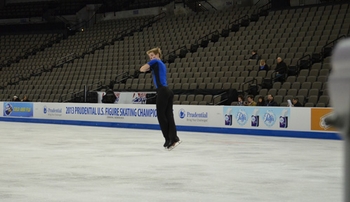On the ice they are smooth and graceful, often with soothing music to match. There are few things more elegant than elite figure skating. Except … SPLAT!
“I was trying to make snow angels,” joked a championship men’s skater (he shall remain nameless) during a practice last week at the U.S. Figure Skating Championships 2013.
 |
Medical teams often sit rinkside as skaters compete in the U.S. Figure Skating Championships at the CenturyLink Center. |
“Bruises,” said Rusty McKune, The Nebraska Medical Center’s sports medicine program coordinator and coordinator of the team staffed by the three med center entities. “Sprains. Strains. You’ll see concussions. Fortunately, we haven’t seen any significant lacerations from the skate blades.”
As he spoke, he peeked, stretching his neck to check the action on the ice every second or so. In addition to staffing the medical room in the bowels of the CenturyLink Center, the med center team is rinkside, too.
That’s where Beau Konigsberg, M.D., assistant professor of orthopaedic surgery, was assigned. Luckily, it had been pretty boring, he said – at least injury-wise.
Still, the team had a great time being that close to an event like this.
“I was surprised at the athleticism, and the potential for serious injury,” Dr. Konigsberg said.
McKune said the medical team was made up of 128 people, collectively providing 1,100 man-hours of coverage.
“It’s a great collaborative effort between the three entities,” he said.
In addition to the regular cast of physicians, nurses, physical therapists and athletic trainers, a crew from pharmacy has also helped make it all go.
“The pharmacists have played a vital part,” McKune said. Every prescription had to be checked against drug-testing guidelines.
So what kind of injuries did the medical team see? A lot of chronic injuries, the nagging kind skaters just live with, and can’t seem to shake. Sore throats. Gastroenteritis.
You know – smooth, graceful, glamorous stuff.
We forget sports medicine encompasses everything, McKune said. And that’s why these skaters needed everyone. They were in good hands with the crew from UNMC, TNMC and UNMCP.
“The plan was to have all of these different professionals coming in and letting them be the experts in their field of expertise,” McKune said.
Good thing. Because underneath all the sparkle, there are purple ankles, stress fractures and bad backs.
As a member of the 2013 Prudential US Figure Skating Championships Local Organizing Committee I served as Ice Monitor Captain. My role was to recruit, schedule and oversee the 50 odd volunteers that worked rink side at practices and competition events-making sure that things ran on time and keeping the paperwork in order. An ice monitor checks in the skaters, lets them on and off the ice and makes sure that coaches and athletes have whatever they need. I was very proud to have UNMC provide medical support for this event!
And of course, being a figure skating enthusiast, I enjoyed absolutely everything about the National Championships! However, seeing athletes achieve a personal best was at the top of my list.